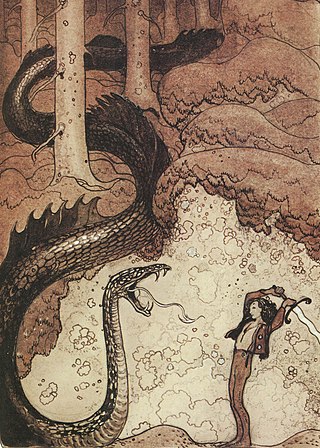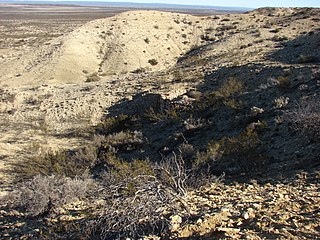
The lindworm, also spelled lindwyrm or lindwurm, is a mythical creature in Northern, Western and Central European folklore that traditionally has the shape of a giant serpent monster living deep in the forest. It can be seen as a sort of dragon.

The Roca Formation is a Cretaceous to Paleogene lithostratigraphic unit, located in the Neuquén Basin. It crops out in the Argentinian provinces of Río Negro, Neuquén, La Pampa, and Mendoza. Its deposition is diachronous, beginning during the Maastrichtian in the north of its distribution, and later moving to the south, where its strata reached the Late Danian. It lies transitionally above the Jagüel Formation, and the top of the formation is marked by a regional unconformity due to an Eocene and Oligocene orogenic pulse. These two units belong to the Malargüe Group. The marine sediments of the Jagüel and Roca Formations were deposited during a transgression from the Atlantic Ocean, beginning in the Maastrichtian and ending in the Danian.
Azabbaremys is an extinct genus of bothremydid pleurodiran turtle that was discovered in the Teberemt Formation of Mali. It was described in 2001, based on a skull that had been recovered in an expedition in 1981. The genus consists solely of the type species Azabbaremys moragjonesi. The genus name is derived from Azabbar, a monster in Tamasheq folk stories. The species is named for Morag Jones, a research student who participated in the discovery of the specimen and died in the expedition. Azabbaremys is most closely related to another Paleocene side-necked turtle, Acleistochelys.
Schizasteridae is a family of echinoderms belonging to the order Spatangoida.
Acleistochelys is an extinct genus of large, bothremydid pleurodiran turtle known from Paleocene deposits in the Teberemt Formation of Mali. The type species, A. maliensis, was named for the country in which it was found. The holotype specimen consists of a nearly complete skull, shell fragments, pelvic fragments, and a cervical vertebra. It is most closely related to another Paleocene Malian side-necked turtle, Azabbaremys.

